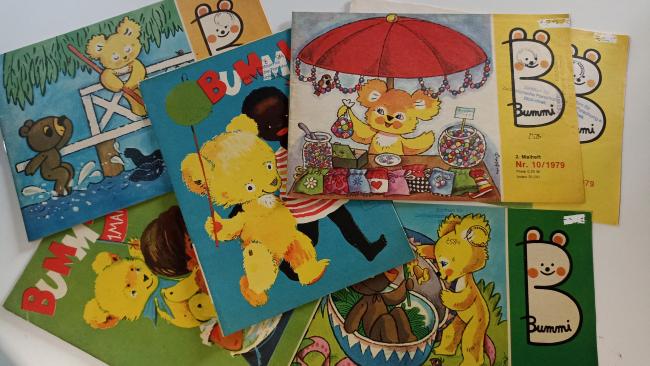Many people socialised in the GDR can probably still hum the tune of Bummi, the bear from Toyland, with confidence. The magazine of the same name accompanied several generations through their kindergarten years - cute, didactic and socialist. In February, the shaggy, yolky-yellow teddy bear from Toyland, designed by the well-known children's book illustrator Ingeborg Meyer-Rey, turned 60 years old. On this occasion, an exhibition was opened on Sunday at the Rochow Museum in Reckahn, which for the first time is dedicated to the magazine, sheds light on its political and artistic framework, examines the educational concept and ideological orientation, but also presents the extensive merchandising (even if it wasn't called that in GDR times) surrounding the cuddly bear and his friends. For us, the exhibition, which will be on display until 10 December 2017, is reason enough to draw attention to children's and youth magazines from the GDR that are in the library's collection. Come and browse and learn how the GDR was presented to children's eyes.
ABC-Zeitung (Z 590)
The "ABC-Zeitung" was the oldest GDR children's magazine, founded in 1946 and published monthly for 30 pfennigs per issue. The target audience was young pioneers and pupils in grades 1-3. Initially, the magazine was published by Volk und Wissen under the editorship of Kurt Egbert and Malla Naas. Later it became an organ of the FDJ Central Council, published by Junge Welt. The editor-in-chief at the time was the writer Gerhard Holtz-Baumert. From the 1960s onwards, two little round characters named Rolli and Flitzi guided readers through the magazine, later they were joined by a titch named Schnapp. After reunification, the ABC-Zeitung was published by Pabel-Moewig Verlag until 1996. We have some issues from the years 1988 to 1990 in our collection.
Atze (Z 597)
The youth magazine "Atze" was published monthly for 20 pfennigs by Junge Welt from 1955 to 1991. Published by the FDJ Central Council, it was aimed at the Thälmann Pioneers. The illustrated stories often had political content, dealing with topics such as the October Revolution or the communist resistance against National Socialism. From 1958, the non-political mouse comic "Fix und Fax" was also published, which was very popular with readers. Apart from a few gaps, we have the 1983 to 1990 volumes of Atze in our collection.
Bummi (Z 584)
The first issue of "Bummi" was published on 15 February 1957 and the initial monthly publication changed to a bi-weekly cycle shortly afterwards. The Junge Welt publishing house distributed the magazine at a price of 25 pfennigs for children aged three to six. The editor-in-chief at the time was Ursula Werner-Böhnke. She also wrote the lyrics for the Bummi song, which appeared in the 2nd grade music books and was set to music by Hans Naumilkat. Stories with the Russian teddy bear Mischka addressed the German-Soviet friendship in a child-friendly way, but the well-known children's magazine also covered good behaviour and road safety. It has been published by Pabel-Moewig Verlag since 1991. Since 2011, the yellow bear has appeared on children's television KiKA in a three-minute animated series - in the leading role, of course. We have issues from 1961, 1979, 1983 to 1985 and 1987 to 1990 in our collection.
FRÖSI (Z 591)
The magazine ‘FRÖSI’ was first published on 25 June 1953. The name stands for "Fröhlich sein und singen" ("Be happy and sing"), which is also the opening line of a pioneer song by Hans Naumilkat. This was initially the magazine's title, the abbreviation FRÖSI was introduced in 1965. The magazine was published by the Junge Welt publishing house on behalf of the Ernst Thälmann Pioneer Organisation at a retail price of 70 pfennigs. Despite its political orientation, which included propaganda comics and calls for the collecion of secondary raw materials, FRÖSI became a popular children's magazine, mainly due to the comics. For example, the character "Korbine Früchtchen" explained herbs and berries, Mr Ali was led around by his dog Archibald (drawn by Horst Alisch) and Captain Lütt sailed on the water. The overly well-behaved young pioneer Mäxchen (drawn by Richard Hambach) first appeared in 1953, never grew older and was later joined by the not-so-orderly playmate Tüte. In addition to one issue from 1979, we have an almost complete collection from 1983 to 1988.
Mosaik (Z 583)
The first issue of "Mosaik" was published by the publishing house Neues Leben on 23 December 1955. In 1960, the publishing house Junge Welt took over the publication of the magazine. With a circulation of 100,000 copies per issue and 40,000 subscribers, it is still the highest-circulation comic magazine in Germany. The magazine was initially published quarterly, then monthly from June 1957. The comic heroes, first the "Digedags" Dig and Dag, and from 1976 the Abrafaxe Abrax, Brabax and Califax, experience educational adventures spanning 23 centuries of human history. The characters were created by Hannes Hegen, who died in 2014. The magazine has been translated into various languages and has been published in countries including the Netherlands, Finland and Hungary. The online reference work MosaPedia offers in-depth information about the magazine and its stories. According to Mosaik-Verlag, more than half of its readers are now over 30 years old (as of 2009). We have the volumes from 1983 to 1990 almost completely in our collection.
Neues Leben (Z 598)
The GDR youth magazine "Neues Leben" ("New Life") was published by the FDJ Central Council. One of the editors' aims was to promote the political education of young people in line with the GDR system. In fact, however, the magazine, which dealt with everyday topics as well as fashion, film and music, developed into a kind of GDR-style "Bravo", including a column on sex education, which was not written by Dr Sommer but by Prof. Borrmann. After reunification, the magazine was initially taken over by Pabel-Moewig Verlag, but was discontinued at the beginning of 1992. In addition to individual issues from the years 1981, 1982 and 1983, we have the volumes 1984 to April 1990 almost completely in our collection.
Jugend und Technik (Z 582)
The GDR youth magazine "Jugend und Technik" ("Youth and Technology") was published monthly from 1953 to 1991 by the publishing house Junge Welt. It contained scientific and technical reports on new technologies, especially from the socialist brother states. Trade fair reports from the Leipzig trade fairs and the Fair of Masters of Tomorrow were also published. In addition to puzzles and handicraft instructions, there were also book presentations. It is particularly noteworthy that, from 1987 onwards, each issue included a section with instructions for building a do-it-yourself computer, the Ju-Te-Computer. After completion of the basic system, extensions such as an EPROM programming module and memory extensions were added regularly. We have single issues from 1965 and 1982, two from 1983 and then, with a few gaps, the volumes from 1984 to 1990.
Technikus (Z 587)
„Technikus“ war eine populärwissenschaftliche Monats-Zeitschrift für Jugendliche zwischen 10 und 16 Jahren, die von 1963 bis 1990 ebenfalls im Verlag Junge Welt erschien. Es wurden neben hauptsächlich naturwissenschaftlichen Beiträgen auch historische Artikel, sowie Rätsel und Science-Fiction-Kurzgeschichten abgedruckt. Ab Juni 1965 erschien in jedem Heft die „Matheknobelei des Monats“. Unser Bestand weist die Jahrgänge 1983 bis 1990 fast lückenlos auf.
Weiterführende Literatur:
Die Kinderzeitschriften in der DDR von 1946 bis 1960 (10 200)
(18.07.2017)

